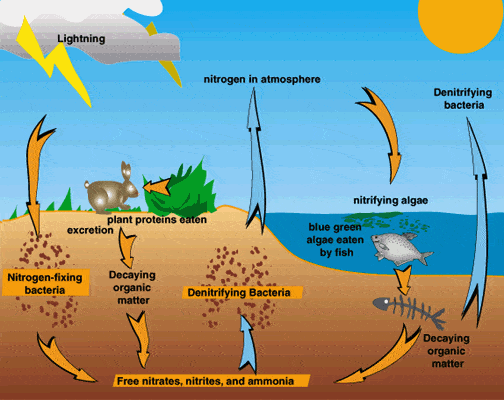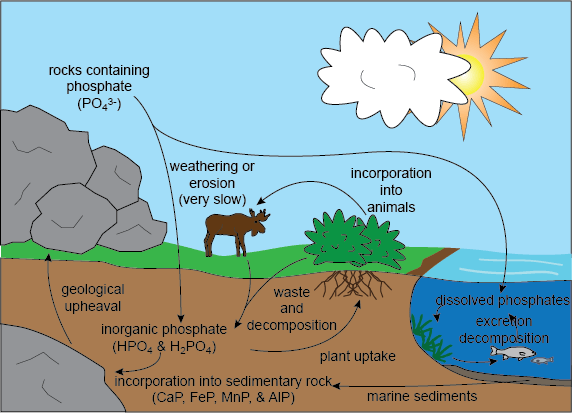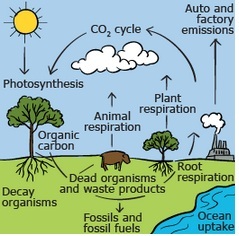Geology- Biogeochemical Cycles
1/86
There's no tags or description
Looks like no tags are added yet.
Name | Mastery | Learn | Test | Matching | Spaced |
|---|
No study sessions yet.
87 Terms
The process of plants losing water through their leaves is called?
transpiration
Why do living things need nitrogen?
To make proteins and amino acids
What is the only process that removes carbon from the atmosphere?
photosynthesis
These gases, such as carbon dioxide, trap heat in the Earth’s atmosphere causing global warming
green house gases
Which nutrient is not cycled through the atmosphere?
carbon
nitrogen
phosphorus
water
phosphorous
This is released by the weathering of rocks.
phosphorus
What is the largest reservoir for the phosphorus cycle?
rocks and minerals
What is the largest reservoir for water?
the ocean

Identify the cycle pictured.
the nitrogen cycle
When nitrogen gas is turned in to a form that plants and animals can use is called
nitrogen fixation

Identify the cycle pictured
the phosphorus cycle
How to animals get nitrogen?
eating other organisms
Which process takes Carbon Dioxide from the air and converts it into a form of carbon used by living things?
photosynthesis
When nitrogen gas is turned in to a form that plants and animals can use is called
nitrogen fixation
What happens when organisms die and decay?
Their nitrogen returns to a soil as ammonium

Identify the cycle pictured.
the carbon cycle
A correct path that nitrogen could take would be?
air → bacteria → plants → animals
How much of the atmosphere is composed of nitrogen gas?
78%
What is happening when one animal is consuming another?
energy is transferred through the food chain
What do the water, carbon, oxygen, nitrogen, a phosphorus cycles have in common?
All involve the constant cycling of substances between animals, plants, and the Earth.
plants absorb what?
nitrates
Which plant is an example of a legume?
strawberries
carrots
peanuts
corn
peanuts
What is the process where plants use nitrates to grow?
Assimilation
Organisms require nitrogen to make which of the following?
proteins and nucleic acids
What is the process where bacteria turns Nitrogen gas from the atmosphere into usable compounds?
nitrogen fixation
How do animals get the nitrogen they need?
From the food they eat
What is the formula for atmospheric nitrogen?
N2
T or F Bacteria fix nitrogen from the atmosphere into a form plants can use.
True
T or F Plants and animals cannot use nitrogen directly from the air.
true
T or F Plants that have nitrogen fixing bacteria in nodules on their roots are known as legumes.
true
What is the main reservoir of nitrogen?
atmosphere
The process that convert nitrates (NO3) back to nitrogen gas (N2) there by replenishing N2 in the atmosphere is called
Denitrification
If the atmosphere is full of N2, why can’t we just get out nitrogen by breathing?
We have no mechanism to break the triple bond of nitrogen between atoms.
Nitrification happens in the _________?
Soil
How do plants get the nitrogen they need?
Absorb through their roots from the sol or water in which they live
T or F Nitrogen-rich fertilizers and manure can cause eutrophication
true
Nitrogen Fixing bacteria change
nitrogen gas into ammonia
Nitrifying bacteria change
ammonia into nitrates
Denitrifying bacteria change..
nitrates into Nitrogen gas
What happens when organisms die and decay?
Their nitrogen returns to the soil
What happens when too much nitrogen finds its way to the ocean?
algae bloom
T or F Decomposers release nitrogen back into the soil in the form of ammonia.
True
Carbon dioxide is absorbed by producers to make what in photosynthesis?
carbohydrates
Which of these does not add CO2 to the atmosphere?
cooking with gas
planting trees
burning wood
riding a bus
planting trees
Burning fossil fuels has raised the concentration of _______ in the atmosphere.
carbon
T or F: The amount of carbon in the atmosphere has NO EFFECT on Earth’s temperature
False
Limestone is a type of rock created from the __________ of dead sea organisms.
shells
Why does too much carbon dioxide in the atmosphere cause climate change?
Traps heat and warms planet
Why is the increase in greenhouse gasses an issue?
It causes climate change and increase in the global temperature
_________ is an essential element of all living creatures.
Carbon
When humans burn fossil fuels, most of the carbon quickly enters the ______________ as carbon dioxide.
atmosphere
The circulation of the element carbon among Earth’s atmosphere, land, oceans, and organisms is called ___________.
the carbon cycle
Which is a greenhouse gas?
carbon dioxide
Over ___________ of years, once-living matter that remains in the ground can transform into fossil fuels.
millions
How does the carbon in grass become part of a living animal?
it ends up in its food chain
Since the mid-1800’s, _________ activity has significantly altered the carbon cycle.
human
Organisms that die in the ocean may _______ to the bottom and form limestone rock of a period of time.
sink
Which of the following adds oxygen to the atmosphere?
forest fires
photosynthesis
weathering of rocks
life processes of animals
photosynthesis
Deforestation contributes to the greenhouse gasses by?
loss of trees that would otherwise remove carbon dioxide from the air
How do living organisms return carbon to the atmosphere in the carbon cycle?
respiration and photosynthesis
Carbon is stored in…
trees and other living things
oceans
underground in soil and fossil fuels
all are correct
all are correct
What happens in Eutrophication?
it is a massive die off of organisms due to low oxygen
What are the dangers of excessive growth of algae and plants?
they block sunlight for other organisms
T or F: Pants are the only organisms that can directly absorb inorganic phosphorus ions (PO43) and turn them into organic molecules that can support all other life processes in an ecosystem
True
In Eutrophication, dissolved oxygen levels decrease because…
bacteria use it as they decompose organic material
Thick layers of algae blocks _____ for photosynthesis
light
What is the original cause of Eutrophication?
excess fertilizer
Too much of a good thing, such as ___________ and _________ nutrients in the lakes and ponds can cause an imbalance resulting in eutrophication
phosphorus, nitrogen
T or F: The phosphorus cycle occurs much more quickly than the carbon and nitrogen cycles
false
Why should farmers be concerned about unused nitrate fertilizer contaminating surface water and groundwater supplies?
excessive amount of nutrients speed up the eutrophication process.
This is NOT a part of the phosphorus cycle
atmospheric phosphate
Which would most likely happen if too many nutrients entered an estuary?
algae blooms would lower dissolved oxygen levels, causing fish to suffocate
When too much ________ grows, it eventually covers the surface of the water
algae
What role do decomposers play in the phosphorus cycle?
return phosphorus into the soil
______ brings phosphorous into our waterways
runoff
This is released by the weathering of rocks
phosphorus
Why is phosphorus important to us in environmental science?
it is a component of many biological molecules, such as, nucleic acids, some lipids, ATP, and bony structures.
Which of the following statements is true of the phosphorus cycle?
the phosphorus cycle utilizes the processes of erosion and weathering
Phosphorus is passes from plants to ______ who eat them
animals
FRQ: Describe a biological process by which carbon is removed from the atmosphere and converted to organic molecules
Photosynthesis removes carbon dioxide from the atmosphere and converts it into organic molecules by using the sun’s energy to convert water and CO2 into glucose.
FRQ: Describe a biological process by which carbon is converted from organic molecules to a gas and returned to the atmosphere.
Cellular respiration converts sugar back into CO2 and H2O and it is released back into the atmosphere.
FRQ: Explain how atmospheric carbon is incorporated into two oceanic sinks.
Atmospheric carbon is incorporated into two oceanic sinks such as ocean absorption and oceanic plants. The ocean absorbs carbon from the atmosphere via precipitation and wave action. Oceanic plants also absorb atmospheric CO2 through photosynthesis and release oxygen to the surface.
FRQ: Identify one terrestrial sink, other than fossil fuels, that stores carbon for thousands to millions of years.
Limestone can store carbon for thousands to millions of years since it is primarily made from the shells of deceased marine animals.
FRQ: The burning of fossil fuels has been shown to increase the concentration of carbon in the atmosphere. Discuss TWO other human activities that increase the concentration of carbon in the atmosphere.
Slash-and-burn techniques and industries increase the concentration of carbon in the atmosphere. The slash and burn technique removes trees that use CO2 by burning them and releasing excess carbon into the atmosphere. The industry like cement manufacturing produces large amounts of CO2 when heating limestone.
FRQ: Identify an environmental problem that results from elevated atmospheric carbon concentrations. Discuss one consequence of the problem you identified.
The greenhouse effect can occur due to elevated amounts of carbon in the atmosphere. This causes the sun’s heat to get trapped and increases the temperature of our planet.
FRQ: Describe one major way in which the phosphorus cycle differs from the carbon cycle.
The phosphorus cycle does not occur in the atmosphere. It starts from the weathering of rocks and sediments.
FRQ: Identify one reason that phosphorus is necessary for organisms.
Phosphorus is necessary for organisms since is forms DNA and RNA which is crucial for genetic information.